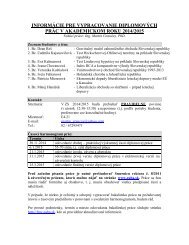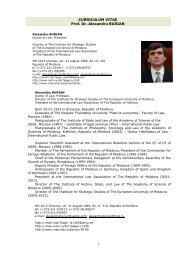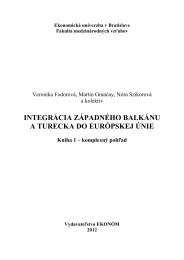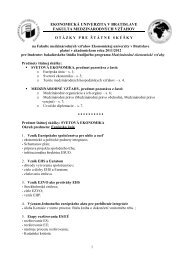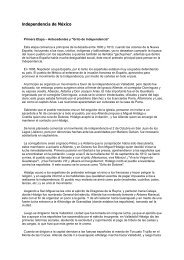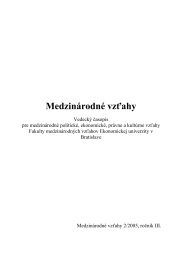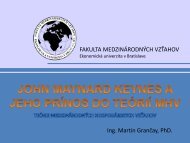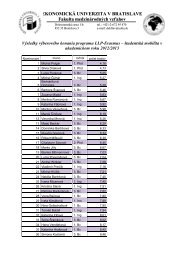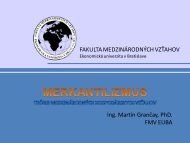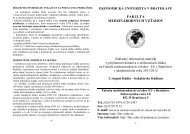rozvojová pomoc a spolupráca - Fakulta medzinárodných vzťahov
rozvojová pomoc a spolupráca - Fakulta medzinárodných vzťahov
rozvojová pomoc a spolupráca - Fakulta medzinárodných vzťahov
- No tags were found...
You also want an ePaper? Increase the reach of your titles
YUMPU automatically turns print PDFs into web optimized ePapers that Google loves.
Development Programme 35 . For the purpose of the chapter, we can simplydefine poverty as the state, when individuals or groups of people do nothave fundamental sources for disposal to ensure their means of living.They find themselves in misery and subsistence insecurity.How to measure poverty?The most commonly way, used to measure poverty at the country level, isbased on incomes or consumption levels. A person is considered poor if his orher consumption or income level falls below some minimum level necessary tomeet basic needs. This minimum level is usually indicated as the "poverty line".What is necessary to satisfy basic needs varies across time and societies.Therefore, poverty lines vary in time and place, each country using the linesappropriate to its level of development, societal norms and values. Informationon consumption and income is obtained through sample surveys, askinghouseholds to answer detailed questions on spending habits and sources ofincome. Such surveys are conducted more or less regularly in most countries.The sample survey data collection methods are increasingly beingcomplemented by participatory methods, where people are asked what theirbasic needs are and what poverty means for them. Interestingly, new researchshows a high degree of concordance between poverty lines based on objectiveand subjective assessments of needs. 36When estimating poverty at the global level, the same reference povertyline has to be used, and expressed in a common unit across countries. Therefore,for the purpose of global aggregation and comparison, the World Bank usesreference lines set at 1 USD and 2 USD per day in 1993 Purchasing PowerParity (PPP) terms (where PPPs measure the relative purchasing power ofcurrencies across countries). It has been estimated that in 1999 1.2 billion peopleworldwide had consumption levels below 1 USD a day. It means 23 % of thepopulation of the developing world and 2,8 billion lived on less than 2 USD aday. Because of the time involved in collecting and processing the householdsurvey data upon which these figures are based, and because of the complexitiesof the estimation exercise, these figures appear with a lag 37 .35 WORLD BANK: Understanding Poverty. [online]. Washington: The World Bank Group,2007. Available from http://www.worldbank.org.36 Ibid. For details see COUDOUEL, A. et al.: Poverty Measurement and Analysis. In: PRSSourcebook. Washington: World Bank, 2002, pp. 29 - 74.37 Ibid.30



